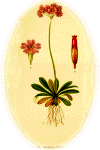


|
|
Finding the Military Orchid Serendipity strikes |
|
|
The Chiltern wood borders are the place to look for the Military Orchid, Orchis militaris. At one time this was not extremely rare, and up to about a century ago there are records of it being seen in considerable numbers. Moreover, the records extend from east of Tring across the Thames into Berkshire; and they were from places well scattered over the Chilterns (Distribution Map, p.222). Then it disappeared from one district after another, until by about 1914 it seemed to be extinct. Whatever the reason for its going - and there are quite a number of theories - there must have been some factor which affected it over a wide area. In May, 1947, I rediscovered the Military Orchid! In a way it was just luck. The excursion was intended as a picnic, so I had left my usual apparatus at homc and took only my note-book. But I selected our stopping places on the chalk with some care, and naturally wandered off to see what I could find. To my delight I stumbled on the orchid just coming into flower. The following week-end I returned to make a careful survey of the colony and to take the first opportunity given to any British botanist for well over thirty years of studying the particular conditions under which the Military Orchid lives in our country. It was on this second visit that I took the colour photograph used for Plate 26 (p.115) - the first to be taken of this plant in England. Careful plotting showed that there were 39 plants in the colony and
that 18 of them had thrown up flowering spikes. Of these, the 5 most exposed
had the flower-stems bitten right off - almost certainly by rabbits. The
plotting also revealed that the plants most in shade either failed to flower
or put up only pale, small spikes. Trees on one side of the colony had
been cut down in the early days of the war, as I estimated from the growth
of bushes round their stumps, and it is likely that this had stimulated
germination of dormant seeds of the orchid. Analysis of a sample of the
soil revealed that the free carbonate of lime amounted to no less than
50.2 per cent-an astonishingly high proportion.
|
It was interesting to compare this locality with the marshes near Brunnen in Switzerland, where I saw the Military Orchid in May, 1930. Whereas on the Chilterns it was growing on a shallow chalk soil under almost the driest possible conditions, in Switzerland it thrived in very wet marshy meadows. It is probable, however, that the soil-water there was basic, although I made no tests at the time. The plants on the Chilterns varied greatly in size. The smallest was only about four inches tall with two flowers - a miserable, depauperate little plant. The largest - the one which is illustrated - was 14 inches (35 cm.) tall with no less than 26 flowers. This must be about the finest Military Orchid seen in England; for most of the herbarium specimens (dating from the time when it was plentiful) are only some 7 to 9 inches in height. The flowers are extremely beautiful; in saying this I think I can fairly say that I have not allowed the rarity of the plant to bias my judgment. The pointed sepals are folded together to form a hood over each flower and are a pale ashy-grey on the outside. The flowers open at the bottom of the spike first and therefore the buds at the top appear slightly pinkish-grey from the colour of the sepals, which act as wrappers. It is the resemblance of the hood to an ancient helmet which has led to the plant being called the Soldier or Military Orchid; the name is a very apt one. The lip, which projects beneath the helmet, has two lobes on each side and one very small pointed terminal one: it is spotted and flushed with a colour which is usually described as pink but which is far less red than is shown in most of the published colour pictures. It is a colour which is very difficult to match, but perhaps comes nearest to the one described as "roseine purple" of the old R.H.S. colour chart. In 1955 a second fine colony of the Military Orchid was discovered in Suffolk - far from previously known habitats. |
| Reproduced
from
Wild Flowers of Chalk and Limestone Collins New Naturalist Series, 1950 with permission |
J. E. Lousley |